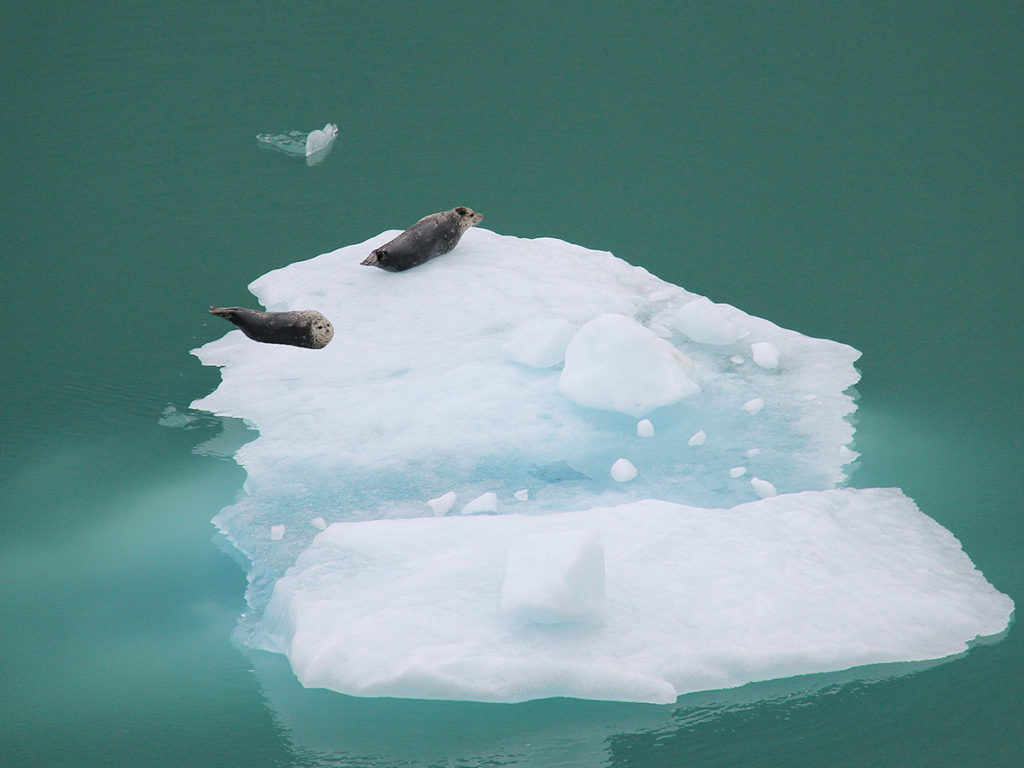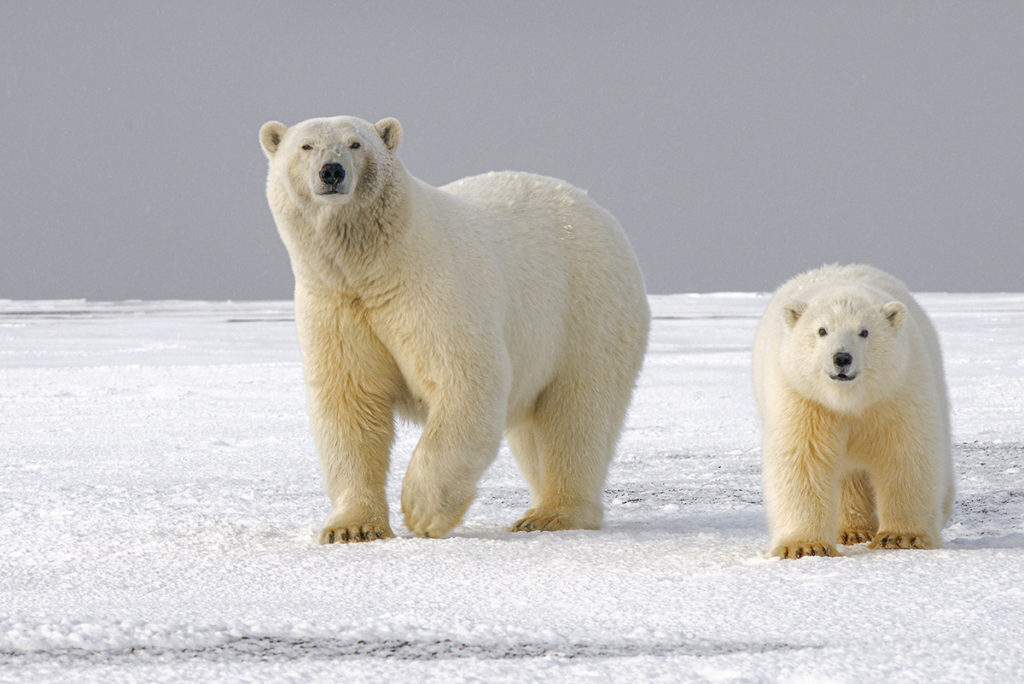Seals are excellent divers with exceptional senses under water. They can be found in every ocean ranging from the freezing Arctic all the way to the Antarctica. They prefer salt waters and cold temperatures but they are some exceptions depending on the species. Seals belong to the family of Pinnipeds with 35 species of seals and including the Walrus. Their diet varies so, in order to learn what seals eat, we need to understand what species we are talking about.
Seals can be divided into two main groups. Which group it is largely depends on whether they have ears, how well adept they are at moving on land and whether or not they have fur. This article will cover seals living in the Arctic, in other words, the Arctic seals.
Arctic Seal Species
There are six species of seal that live parts of the Arctic ocean. These species belong to the Phocidae family, and are referred to as “true seals” and have no visible ears. The 6 Arctic seal species are:
Bearded Seal
The largest of the Arctic seals, males grow as long as 8ft and as heavy as 950lbs. Unlike most other seal species, females are typically longer and heavier than males. They have a dark grey body with white, cream, ginger or pale grey fur on their face. Bearded seals have the nickname of Square Flipper seal due to the shape of their front flippers.
What do Bearded seals eat? They mostly hunt clams, squid and arctic cod from shallow waters. However, they also occasionally eat American Plaice and other flatfish species. Just like Walruses, Bearded seals use their bushy whiskers to feel along the seabed in search of food.
Harp Seal
Approximately 2ft shorter in length than Bearded seals, Harp seals are easily recognisable from their distinctive V-shaped (harp-shaped) black marking along their back. They are social creatures, living in large colonies of a few hundred individuals. However, that number rises into the thousands during the breeding season.
Harp seals have one of the most varied diets among Arctic species, mainly owing to their ability to hold their breath for as long as 15 minutes! Research from the IUCN discovered Harp species prey on more than 60 species of fish and 70 invertebrate species. This includes cod, halibut and plaice, plus crabs, krill and shrimp.
Hooded Seal
Also known as the Bladder-nosed seal, male Hooded seals have bizarre skin sacs on their nose that they inflate with air to display to males and attract females. They also have a skin sac in their nose which is blown up like a balloon. Hooded seals grow up to a foot longer than Bearded seals but weigh 200-300lbs less.
The typical diet of a Hooded seal is redfish, arctic cod, herring, octopus and shrimp. They spend some time in open ocean, but most of their hunting is done close to pack-ice. This offers protection from predators such as Greenland sharks and Orcas.

Ribbon Seal
This average sized seal is possibly the most distinctive. The body is dark grey fur with thick pale grey bands, or “ribbons” going in various directions across the body and around the neck. Ribbon seals grow to approximately 5ft in length, with very little difference between males and females.
Juvenile Ribbon seals feed predominantly on shrimp and other small crustaceans, whereas adult Ribbon seals eat squid, shrimp and various species of fish. During the winter, most hunting is done close to pack-ice, but hunting during summer is done in open water.
Ringed Seal
The most common seal species in the Arctic, Ringed seals are also the smallest with a maximum adult length of 5ft and a weight of no more than 315lbs. They are pale grey with dark grey rings or patches across their back.
Ringed seals prefer to eat schooling fish such as cod, stickleback and herring. However, they will also hunt krill, shrimp and other small crustaceans. As with Ribbon seals, juvenile Ringed seals eat more crustaceans than adult seals and their preference for fish increases as they mature.
Spotted Seal
As the name suggests, these seals have lots of dark grey spots over a silver-grey coat. They are solitary animals, except for the breeding season. That is when a male and female will stay together until their pup is weaned.
The Spotted seal diet consists of herring, arctic cod and pollock, but they will also hunt for molluscs and crustaceans such as krill, shrimp and squid.
Also Read: Where Do Puffins Live?
Arctic Seal Habitat
All six of these seal species are found in parts of the Arctic ocean, either on floating pack-ice or in open water. They can also be found in neighbouring oceans from Canada, across to Norway, Finland, Japan and Russia.
The Gulf of St Lawrence on Canada’s east coast and the Barents Sea north of Finland and Russia are home to Harp and Hooded seals.
Bearded, Ribbon, Ringed and Spotted seals can be found in the Bering Sea which lies between the west coast of Canada and the east coast of Russia.
Ribbon, Ringed and spotted seals can also be found in the Sea of Okhotsk on Russia’s east coast, north of Japan. Bearded seals are also often spotted in the Laptev Sea, north of Russia.
Arctic Seal Predators
Seals are a main prey item for Polar Bears, particularly Bearded and Harp seals, as they stay near the water edge or utilise floating pack-ice.
Other predators of Arctic seals include:
- Greenland sharks
- Orcas (killer whale)
- Wolves
- Arctic Foxes
- Walruses
Wolves and Arctic foxes predate mostly on pups and juvenile seals due to their small size and vulnerability. Predation from Walruses is rare, but it does happen, most often during the winter when food is scarce.

The most dangerous time for an Arctic seal is when they venture into the water to hunt for food. Most of their predators live in the sea, however, going off to hunt leaves the pups at risk from land-based carnivores. Most seal pups can swim within a few hours of birth, which gives them a slight advantage.
Arctic Seal Social Structure
Each seal species is different when it comes to their lifestyle. Bearded seals are solitary, only spending time with other seals during the breeding season between March and June. Males do not help to care for the pups.
Harp seals migrate south to their breeding grounds. Courtship takes place on land, but mating occurs in the water. Hunting is often done in pods consisting of dozens or even hundreds of individuals.
Hooded seals are solitary like Bearded seals. They only come together to breed. Pups are weaned off their mother’s milk after just 5 days! That is the shortest weaning period of any mammal.
In complete contrast, Ringed seals are very social, building lairs in the snow for protection and huddling together in groups.
Ribbon seals are also solitary, forming loose colonies during the breeding season. It is because pups can be weaned on land or ice packs. For the rest of the year, Ribbon seals live in the water and do not seek out interaction with other seals.
Unlike other Arctic seals, Spotted seals are annually monogamous. This means they choose one partner for that year. A male and female will remain together until the pup is weaned. However, they do not return to the same partner each year.
Also Read: What Temperature Should I Set My Thermostat in Winter?

